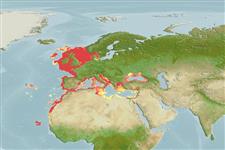Classification / Names
Common names from other countries
Main reference
Size / Weight / Age
Max length : 50.0 cm TL male/unsexed; (Ref. 3397); common length : 27.6 cm FL male/unsexed; (Ref. 3294); common length :20.4 cm FL (female); max. reported age: 21 years (Ref. 26811)
Length at first maturity
Lm 26.6 range ? - ? cm
Environment
Marine; demersal; depth range 15 - 400 m, usually 30 - 250 m (Ref. 35388)
Climate / Range
Temperate, preferred ?; 62°N - 15°N, 32°W - 42°E
Distribution
Short description
Dorsal
spines
(total): 9 - 10;
Dorsal
soft rays
(total): 17-18;
Anal
soft rays: 16 - 18. Head large, without deep occipital groove. First dorsal spine serrate anteriorly, second spine not elongate. Lateral line scales plate-like expanded vertically. Breast and anterior part of belly without scales. Vertebrae 36-37 (13-14 precaudal and 22-23 caudal). Pectoral fin with last 3 rays free. Snout steep, prolonged forward by a denticulated and bilobed flattened rostrum.
IUCN Red List Status (Ref. 115185)
Threat to humans
Harmless
Human uses
Fisheries: minor commercial
More information
ReferencesAquacultureAquaculture profileStrainsGeneticsAllele frequenciesHeritabilityDiseasesProcessingMass conversion
Tools
Special reports
Download XML
Internet sources
Estimates of some properties based on models
Phylogenetic diversity index
PD50 = 0.5010 many relatives (e.g. carps) 0.5 - 2.0 few relatives (e.g. lungfishes)
Trophic Level
3.8 ±0.1 se; Based on diet studies.
Resilience
Medium, minimum population doubling time 1.4 - 4.4 years (K=0.3; tm=2)
Vulnerability
Moderate to high vulnerability (45 of 100)
Price category
